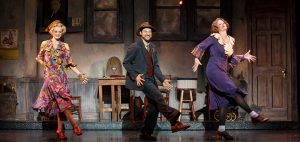Posted March 27, 2017
By LINGYUE ZHENG
If any 40-year-old could still wring people’s hearts simply with her pleading voice, mist you up when she calls out Daddy, and leap onto a conference table halfway through a meeting at the White House without triggering alarm and convert a room of politicians to a cheerful choir, it must be magic.

Macy (Sandy) and Tori Bates (Annie) (Photo courtesy of “Annie” the Musical Web site).
The magic is the musical “Annie.”
When the iconic image of a girl in a red dress with red hair sitting next to a puppy came to the Ziff Ballet Opera House at the Adrienne Arsht Center in Miami, adults as well as kids beamed in joyful anticipation and gave rounds of applause as the latest incarnation of “Annie” became an unstoppable sunshine steamroller.
Premiering at the Alvin Theatre in 1977, the famed Broadway musical “Annie” was originated from Harold Lincold Gray’s cartoon strip “Little Orphan Annie.” It has been applauded and loved by generations and generations. It is still adored by people who are willing to pay from $30 to $100 to watch this dreamlike fantasy.

From left, Mallory King (Lily), Michael Santora (Rooster Hannigan) and Erin Fish (Miss Hannigan) in “Easy Street” (Photo courtesy of “Annie” the Musical).
The fully packed Ziff Ballet Opera House showcased audience’s enthusiasm and optimism about the musical even before the heart-on-sleeve optimism in the play showered the audience.
Directed by original lyricist and director Martin Charnin and choreographed by Liza Gennaro, this production of “Annie” flexed its muscles by making the audience burst into both tears and laughter.
The musical is invariably about our protagonist Annie, an adorable and innocent orphan residing at a Brooklyn Orphanage who kept faith that her parents would come to pick her up. The orphanage matron, Miss Hannigan, held a grudge against orphans and found faults with the kids. So, Annie managed to escape from the orphanage by hiding in a laundry bag, but she was sent back by the police.
Coincidently, business tycoon Daddy Warbucks, as part of his community service, sought to invite an orphan to his house to celebrate Christmas. His faithful secretary, Grace Farrel, chose Annie and brought her back to Warbucks’ grand mansion.
Later on, the story became a fairy tale of sorts when Daddy Warbucks not only opened his house to Annie, but he gradually opened his heart to this round face girl. More dramatically, Annie even attended one of President Roosevelt’s cabinet meetings and indirectly helped a room of politicians come up with the New Deal by simply singing the well-known “Tomorrow” together.

Annie (Tori Bates) and Daddy Warbucks (Gilgamesh Taggett) are dancing and singing in the last scene (Photo courtesy of “Annie” the Musical).
With Warbucks’ love for the child soaring, he tries to help Annie find her parents and, after some trouble caused by Miss Hannigan and her brother, Warbucks eventually adopts Annie.
The entire musical is filled with high energy and dynamic performances that could elicit audience’s laughter when Ms. Hannigan was acting outrageously or referring to her wine as medicine. Also, the show would mist you up when little Annie wrapped her arms around her Daddy Warbucks.
Gilgamesh Taggett, who played the tycoon entrepreneur Oliver Warbucks, is surely worthy of attention. Warbucks was the only character in the play who demonstrated the complexity of humanity. He, on the one hand, was a businessman who owned factories that manufactured goods sustaining the nation. On the other hand, he revealed his gentle, soft and caring self when he found little Annie to share his glory.
Taggett is a veteran on stage. He played Satan in “Jerry Springer the Opera,” the Constable in “Fiddler On the Roof” and other numerous on-stage experiences of bringing out a villain and a saint.
Taggett meticulously brought out the complexity of Warbucks through his fine acting. He would cautiously tie up the last button on his suits when he stood up and maintained a tough and stern facial expression when he handled business. But he also ventured into naturalism to express his emotion, inflecting his songs with unexpected emotional variety.
The emotional subtlety and variety of Warbucks’ presented by Taggett earned people’s hearts not only for the red hair, little chubby orphan Annie, but also for the loving billionaire Oliver Warbucks.

The iconic image of the musical “Annie” could spark people’s optimism.
This Broadway musical is set during the Great Depression when New York was a shabby and embattled city, reeling from the threat of national bankruptcy.
The audience never gets tired of Annie’s unusual and unrealistic experience because generations after generations need the overwhelming “Annie optimism” to combat with self doubts and real life dilemma.
Now, as the whole country slowly recovers from the crippling economy, and the country wrestles with an uncertain future not so unlike those previous headache problems, here comes “Annie” once again, encouraging people to stick out their chins and grin.
The musical “Annie” has just the right warmth for audiences to have a respite from life’s coldness. It was cute without being cutesy and sweet without being too sugary.
If anyone wants to be recharged with energy and hope, this latest production of “Annie” is the ideal outlet.
- Name: “Annie”
- Date: March 4 – March 6, 2017
- Ziff Ballet Opera House at the Adrienne Arsht Center, Miami
- Director: Martin Charnin
- Choreography: Liza Gennaro
- Cast: Tori Bates/ Gilgamesh Taggett/ Erin Fish/ Casey Prins
- Run time: 2 hours, 30 minutes
- Parental Guide: 8+
- Rating: 7.33/10 (average critics rating)
